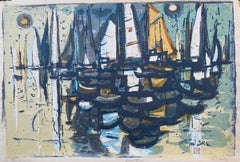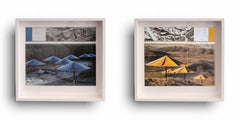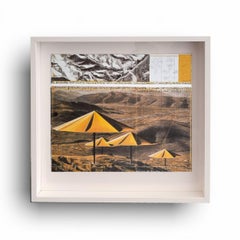Phil Dike Art
to
1
1
1
Overall Height
to
Overall Width
to
1
1
1
1
1
6,910
3,236
2,514
1,217
1
Artist: Phil Dike
SUN GLOW
By Phil Dike
Located in Santa Monica, CA
PHIL DIKE (1906 - 1990)
SUN GLOW . 1960
Color serigraph, edition 25. Signed, numbered and tItled in pencil .
Image 15 x 23 inches. Sheet 16 1/2 x 23 1/2 in...
Category
1960s Modern Phil Dike Art
Materials
Screen
Related Items
The Umbrellas (BOTH FRAMED - BLACK OR WHITE ... YOU CHOOSE + FREE U.S. SHIPPING)
By Christo and Jeanne-Claude
Located in Kansas City, MO
COULD ALSO BE FRAMED IN A BLACK FRAME - SAME SIZE & MODEL
Christo
The Umbrellas (Yellow & Blue)
Lithoserigraphs
Year: 1991
Size: 14.6 × 16.4 on 19.1 × 19.9 inches (EACH)
Framed: 20....
Category
1990s Modern Phil Dike Art
Materials
Lithograph, Screen
H 20.5 in W 20.5 in D 2.5 in
The Umbrellas (Yellow) (FRAMED - BLACK OR WHITE - YOU CHOOSE - FREE US SHIPPING)
By Christo and Jeanne-Claude
Located in Kansas City, MO
Christo
The Umbrellas (Yellow) (FRAMED - either black or white frame - you choose)
Lithoserigraph
Year: 1991
Size: 14.6 × 16.4 on 19.1 × 19.9 inches
Framed: 20.5 x 20.5 x 2.5 inches
...
Category
1990s Modern Phil Dike Art
Materials
Lithograph, Screen
H 20.5 in W 20.5 in D 2.5 in
Original "Wagon Lits" pop art style serigraph travel by train poster
By Valerio Adami
Located in Spokane, WA
Original “Wagon Lits” serigraph poster by the artist Valerio Adami.
It was printed in France by GrafiCaza (Michel Caza), one of the finest serigraph companies on woven paper—in exce...
Category
1990s American Modern Phil Dike Art
Materials
Screen
H 36 in W 24 in D 0.05 in
Original "Japan" vintage travel poster serigraph bicycle
Located in Spokane, WA
Original Japan serigraph travel poster. Linen backed in very find condition, ready to frame.
Japanese travel posters have a rich history and are renowned for their captivating ...
Category
1970s Modern Phil Dike Art
Materials
Screen
The Umbrellas (Blue) (FRAMED - BLACK OR WHITE - YOU CHOOSE - FREE US SHIPPING)
By Christo and Jeanne-Claude
Located in Kansas City, MO
Christo
The Umbrellas (Blue) (FRAMED - either black or white frame - you choose)
Lithoserigraph
Year: 1991
Size: 14.6 × 16.4 on 19.1 × 19.9 inches
Framed: 20.5 x 20.5 x 2.5 inches
Pr...
Category
1990s Modern Phil Dike Art
Materials
Lithograph, Screen
H 20.5 in W 20.5 in D 2.5 in
Modernist Silkscreen Screenprint 'El Station, Interior' NYC Subway, WPA Artist
By Anthony Velonis
Located in Surfside, FL
screenprint printed in color ink on wove paper. New York City subway station interior.
Anthony Velonis (1911 – 1997) was an American painter and designer born in New York City who helped introduce the public to silkscreen printing in the early 20th century.
While employed under the federal Works Progress Administration, WPA during the Great Depression, Velonis brought the use of silkscreen printing as a fine art form, referred to as the "serigraph," into the mainstream. By his own request, he was not publicly credited for coining the term.
He experimented and mastered techniques to print on a wide variety of materials, such as glass, plastics, and metal, thereby expanding the field. In the mid to late 20th century, the silkscreen technique became popular among other artists such as Robert Rauschenberg and Andy Warhol.
Velonis was born into a relatively poor background of a Greek immigrant family and grew up in the tenements of New York City. Early on, he took creative inspiration from figures in his life such as his grandfather, an immigrant from the mountains in Greece, who was "an ecclesiastical painter, on Byzantine style." Velonis attended James Monroe High School in The Bronx, where he took on minor artistic roles such as the illustration of his high school yearbook. He eventually received a scholarship to the NYU College of Fine Arts, into which he was both surprised and ecstatic to have been admitted. Around this time he took to painting, watercolor, and sculpture, as well as various other art forms, hoping to find a niche that fit. He attended NYU until 1929, when the Great Depression started in the United States after the stock market crash.
Around the year 1932, Velonis became interested in silk screen, together with fellow artist Fritz Brosius, and decided to investigate the practice. Working in his brother's sign shop, Velonis was able to master the silkscreen process. He reminisced in an interview three decades later that doing so was "plenty of fun," and that a lot of technology can be discovered through hard work, more so if it is worked on "little by little."
Velonis was hired by Mayor LaGuardia in 1934 to promote the work of New York's city government via posters publicizing city projects. One such project required him to go on a commercial fishing trip to locations including New Bedford and Nantucket for a fortnight, where he primarily took photographs and notes, and made sketches. Afterward, for a period of roughly six months, he was occupied with creating paintings from these records. During this trip, Velonis developed true respect and affinity for the fishermen with whom he traveled, "the relatively uneducated person," in his words.
Following this, Velonis began work with the Public Works of Art Project (PWAP), an offshoot of the Civil Works Administration (CWA), where he was assigned to serve the different city departments of New York. After the formation of the federal Works Progress Administration, which hired artists and sponsored projects in the arts, he also worked in theater.
Velonis began working for the federal WPA in 1935. He kept this position until 1936 or 1938, at which point he began working in the graphic art division of the Federal Art Project, which he ultimately led. Under various elements of the WPA program, many young artists, writers and actors gained employment that helped them survive during the Depression, as well as contributing works that created an artistic legacy for the country.
When interviewed in December 1994 by the Library of Congress about his time in the WPA, Velonis reflected that he had greatly enjoyed that period, saying that he liked the "excitement" and "meeting all the other artists with different points of view." He also said in a later interview that "the contact and the dialogue with all those artists and the work that took place was just invaluable." Among the young artists he hired was Edmond Casarella, who later developed an innovative technique using layered cardboard for woodcuts.
Velonis introduced silkscreen printing to the Poster Division of the WPA. As he recalled in a 1965 interview: "I suggested that the Poster division would be a lot more productive and useful if they had an auxiliary screen printing project that worked along with them. And apparently this was very favorably received..."
As a member of the Federal Art Project, a subdivision of the WPA, Velonis later approached the Public Use of Arts Committee (PUAC) for help in "propagandizing for art in the parks, in the subways, et cetera." Since the Federal Art Project could not be "self-promoting," an outside organization was required to advertise their art more extensively. During his employment with the Federal Art Project, Velonis created nine silkscreen posters for the federal government.
Around 1937-1939 Velonis wrote a pamphlet titled "Technical Problems of the Artist: Technique of the Silkscreen Process," which was distributed to art centers run by the WPA around the country. It was considered very influential in encouraging artists to try this relatively inexpensive technique and stimulated printmaking across the country.
In 1939, Velonis founded the Creative Printmakers Group, along with three others, including Hyman Warsager. They printed both their own works and those of other artists in their facility. This was considered the most important silkscreen shop of the period.
The next year, Velonis founded the National Serigraph Society. It started out with relatively small commercial projects, such as "rather fancy" Christmas cards that were sold to many of the upscale Fifth Avenue shops...
Category
1980s American Modern Phil Dike Art
Materials
Screen
Michael Gross Israeli Minimalist Conceptual Art, Abstract Jerusalem Silkscreen
By Michael Gross
Located in Surfside, FL
Michael Gross (Hebrew: מיכאל גרוס; 1920 – 4 November 2004) was an Israeli painter, sculptor and conceptual artist.
Michael Gross was born in Tiberias in the British-administered Palestine in 1920. He grew up in the farming village of Migdal. In 1939-1940, he left to study at the Teachers’ Training College in Jerusalem. In 1939, while he was away, his father was murdered by Arabs, and the family farm and home were destroyed. This event impacted on his work as an artist.
From 1943 to 1945, he studied architecture at Technion – Israel Institute of Technology in Haifa. From 1951 to 1954, he studied art at the École nationale supérieure des Beaux-Arts in Paris. He returned to Israel in 1954 and settled in the artists’ village of Ein Hod.
Gross's works are imbued with the light and spirit. They are minimalist, but never pure abstraction, always tied to natural form and laden with feeling. In his early paintings, Gross simplified form in order to concentrate on proportion, broad areas of color, and the size and placement of each element. This reductive process was also notable in his sculptures, whether in painted iron or other materials such as white concrete. In later paintings, he often juxtaposed large off-white panels with patches of tone, adding textured materials such as wooden beams, burlap and rope. Gross’s rough, freely-brushed surfaces, along with the use of soft pastel coloring, conjure up images of the Israeli landscape.
Education
1936-1940 Teachers Seminary, Jerusalem
1943-1945, Technion, Haifa, architecture, studied sculpture with Moshe Ziffer.
1951-1954 Beaux Arts, Paris with Michel Guimond
Teaching
1954 - 1954 Higher School of Education, Haifa.
1957-1960 Bezalel Academy of Arts and Design, Jerusalem
1960-1980 Oranim Art Institute, Tivon
Awards
1964: Hermann Struck Prize
1967: Dizengoff Prize
1971...
Category
1970s Modern Phil Dike Art
Materials
Lithograph, Screen
"Lunchtime - 5" Fluorescent Multi Layer Silkscreen on Paper
Located in Soquel, CA
"Lunchtime - 5" Fluorescent Multi Layer Silkscreen on Paper
Incredibly vibrant screenprint by Tatsuo Matsubara (Japanese, b. 1941). The sky and water in this piece are bright magent...
Category
1970s Modern Phil Dike Art
Materials
Ink, Screen, Paper
H 21.5 in W 31 in D 0.01 in
Road to Horizon
By Chase Chen
Located in Paonia, CO
Road To Horizon by Chinese/American artist Chase Chen depicts a hillside with a road that leads up to some trees on the top of the hill silhouetted against a blue sky and scattered clouds perhaps at sunset. Original limited edition [ 346/350 ] serigraph signed in pencil and in very good condition with two small creases in the outer margins on the lower left. Paper size 29.50 x 35.25 image 24 x 30.50.
Born into a family of doctors and growing up during the cultural revolution Chinese...
Category
1990s American Modern Phil Dike Art
Materials
Screen
Roof Shadows
By Chase Chen
Located in Paonia, CO
Roof Shadows shows a surreal landscape with a door leading into a forest of trees. A limited edition ( 321/350 ) serigraph signed in pencil by the artist. In very good condition. Paper size 30.25 x 42.50 image 25 x 37.50.
Born into a family of doctors and growing up during the cultural revolution Chinese...
Category
1980s American Modern Phil Dike Art
Materials
Screen
Nocturnal Village - Original Screen Print by Lucie Navier
By Lucie Navier
Located in Roma, IT
Nocturnal Village is an original artwork realized by the French artist Lucie Navier (1910-1996) in the 1930s.
Original black and white serigraph...
Category
1930s Modern Phil Dike Art
Materials
Screen
H 9.26 in W 8.27 in D 0.04 in
Original "Think American" USA World War II vintage poster
Located in Spokane, WA
Original poster: For a Country Where We Are Still Masters of Our Own Destinies, Let's Be Truly Thankful. Silk-screened patriotism. This is a poster meant to appeal to the American family. Soft, rich colors and a patriotic vision...
This poster has been archivally mounted on linen and is in fine condition condition. Touched up pin-holes in the corners. A- condition.
The Original Think American, USA World War 2 Poster is a captivating piece of history and art. This vintage poster showcases a unique design that captures the era's essence. It features a pilgrim couple gazing out to sea towards their three-master schooner, representing America's pioneering and adventurous spirit. The outline of the United States is a powerful symbol of national pride and strength. The large text along the bottom of the poster delivers a thought-provoking message, reminding viewers to be grateful for the country where they can shape their own destinies. Created and printed by Think America, a renowned brand, this poster is a true collector's item that celebrates American history and values.
The ghosted image of early Pilgrims seems to reach out to the American family who are standing on an outline of the United States. The old sailing...
Category
1940s American Modern Phil Dike Art
Materials
Screen
H 27.25 in W 20 in D 0.05 in
Phil Dike art for sale on 1stDibs.
Find a wide variety of authentic Phil Dike art available for sale on 1stDibs. You can also browse by medium to find art by Phil Dike in screen print and more. Much of the original work by this artist or collective was created during the 1960s and is mostly associated with the modern style. Not every interior allows for large Phil Dike art, so small editions measuring 23 inches across are available. Customers who are interested in this artist might also find the work of Richard Florsheim, Samuel Chamberlain, and Virgil Trasher. Phil Dike art prices can differ depending upon medium, time period and other attributes. On 1stDibs, the price for these items starts at $575 and tops out at $575, while the average work can sell for $575.


